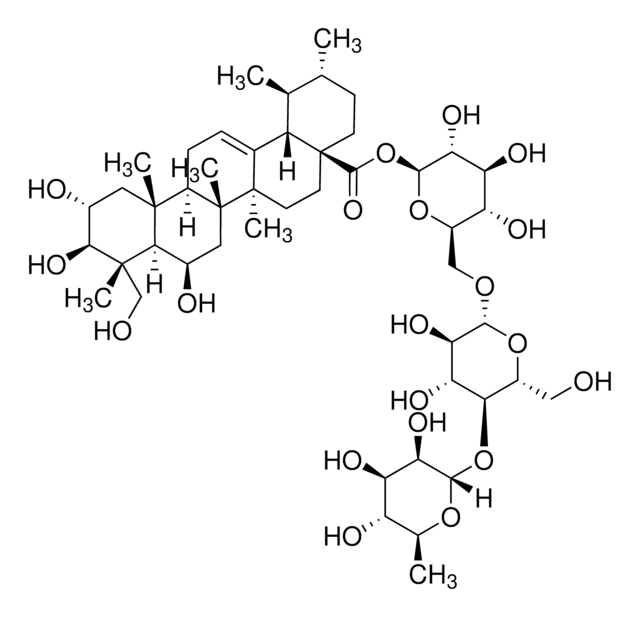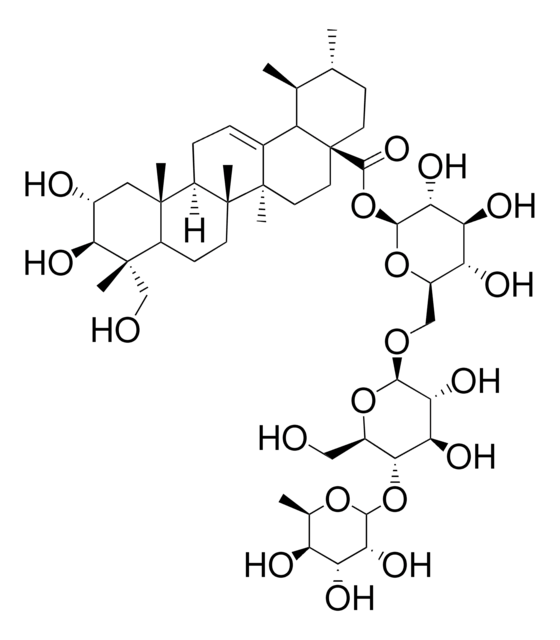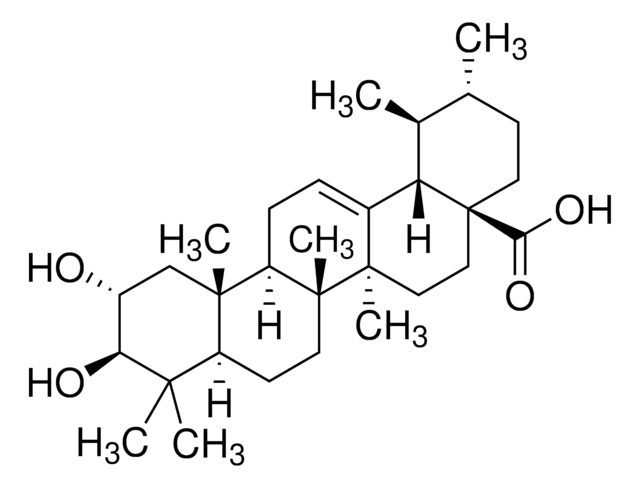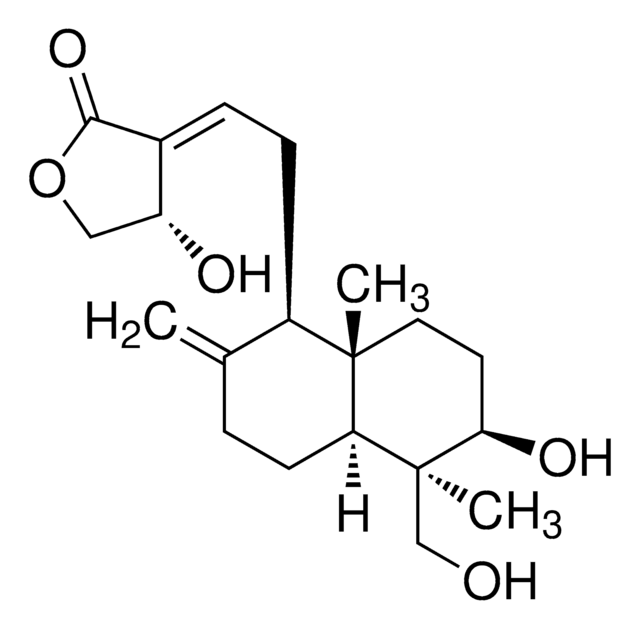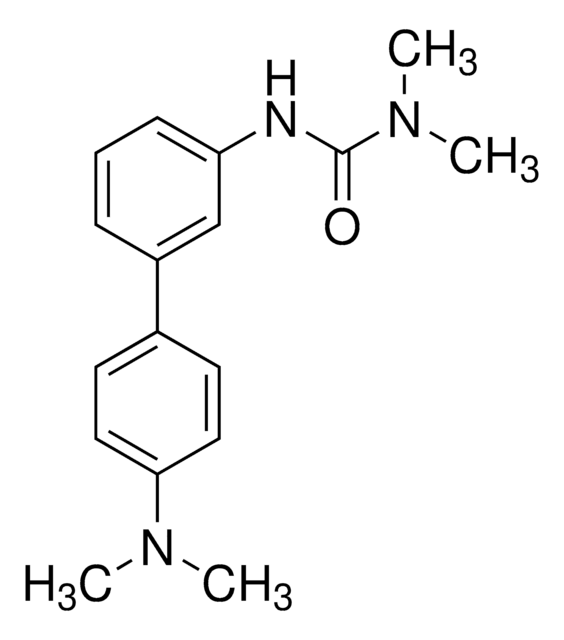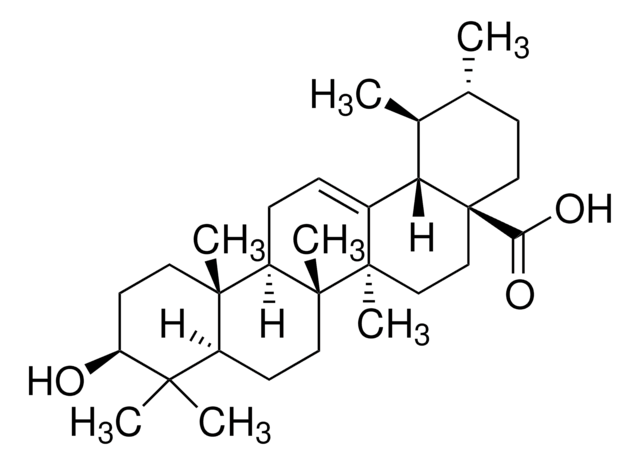추천 제품
생물학적 소스
Centella asiatica
Quality Level
분석
≥98% (HPLC)
양식
powder
저장 조건
protect from light
색상
white
mp
325-330 °C (lit.)
solubility
methanol: 1 mg/mL, clear, colorless
응용 분야
metabolomics
vitamins, nutraceuticals, and natural products
저장 온도
2-8°C
SMILES string
C[C@@H]1CC[C@@]2(CC[C@]3(C)C(=CC[C@@H]4[C@@]5(C)C[C@@H](O)[C@H](O)[C@@](C)(CO)[C@@H]5CC[C@@]34C)[C@@H]2[C@H]1C)C(O)=O
InChI
1S/C30H48O5/c1-17-9-12-30(25(34)35)14-13-28(5)19(23(30)18(17)2)7-8-22-26(3)15-20(32)24(33)27(4,16-31)21(26)10-11-29(22,28)6/h7,17-18,20-24,31-33H,8-16H2,1-6H3,(H,34,35)/t17-,18+,20-,21-,22-,23+,24+,26+,27+,28-,29-,30+/m1/s1
InChI key
JXSVIVRDWWRQRT-UYDOISQJSA-N
유사한 제품을 찾으십니까? 방문 제품 비교 안내
일반 설명
Asiatic acid is a naturally occurring pentacyclic triterpenoid, obtained from Centella asiatica.
애플리케이션
Asiatic acid has been used in the in vitro study of its cytotoxic potential in glioblastoma cells. It has also been used for the in vivo quantitative analysis of asiatic acid in Centella asiatica L. and in vitro study of enhancement of asiatic acid yield upon using organic elicitors.
Starting material for asiatic acid derivative synthesis for use as:
- Anticancer agents
- Glycogen phosphorylase inhibitors
- Hepatoprotectants
생화학적/생리학적 작용
Asiatic acid has been reported to exhibit a pernicious effect on glioblastoma, breast, liver, melanoma, and colon cancers and anti-angiogenic activity. Additionally, it can cross the blood-brain barrier and cause apoptosis in human malignant glioma and hepatoma cells. Asiatic acid also effectively inhibits the Ultraviolet A modulated signal transduction pathways and thereby can be used against UVA-induced photoaging of the skin. It has been noted to show antinociceptive and anti-inflammatory properties plus inhibitory effect on neurotoxicity induced by β-amyloid and glutamate.
Asiatic acid is commonly used in wound healing. Asiatic acid has antioxidant, anti-inflammatory and neuroprotective properties.
Storage Class Code
11 - Combustible Solids
WGK
WGK 3
Flash Point (°F)
Not applicable
Flash Point (°C)
Not applicable
이미 열람한 고객
Byung Chul Park et al.
Cancer letters, 218(1), 81-90 (2005-01-11)
Asiatic acid (AA) is a pentacyclic triterpene found in Centella asiatica. In the present study, the mechanism of anticancer effect of AA on skin cancer was investigated. AA decreased viability and induced apoptosis in human melanoma SK-MEL-2 cells in a
Vinayagam Ramachandran et al.
Phytomedicine : international journal of phytotherapy and phytopharmacology, 20(3-4), 230-236 (2012-10-30)
Asiatic acid (AA), a triterpenoid derivative of Centella asiatica, has shown significant biological effects of antioxidant and anti-inflammatory activities. Aim of this investigation was to evaluate the antihyperglycemic effect of AA on the activities of hepatic enzymes of carbohydrate metabolism
Xue-Lian Tang et al.
Biological & pharmaceutical bulletin, 32(8), 1399-1405 (2009-08-05)
Cancer is one of the leading causes of death in the world. The triterpenoid compound asiatic acid derived from the tropical medicinal plant Centella asiatica displays cytotoxic activity on fibroblast cells and several other kinds of cells. The present work
Jun Liu et al.
Diabetes/metabolism research and reviews, 26(6), 448-454 (2010-09-03)
Type 1 diabetes is a chronic condition in which the pancreas produces little or no insulin due to the loss or dysfunction of pancreatic beta cells. This study investigated the beneficial effects of asiatic acid-a triterpenoid compound-preserved beta mass and
M N Nasir et al.
Phytomedicine : international journal of phytotherapy and phytopharmacology, 19(3-4), 311-316 (2011-11-25)
The asiatic acid, a triterpenoids isolated from Centella asiatica was used to delineate its inhibitory effect on acetylcholinesterase (AChE) properties, excitatory post synaptic potential (EPSP) and locomotor activity. This study is consistent with asiatic acid having an effect on AChE
자사의 과학자팀은 생명 과학, 재료 과학, 화학 합성, 크로마토그래피, 분석 및 기타 많은 영역을 포함한 모든 과학 분야에 경험이 있습니다..
고객지원팀으로 연락바랍니다.
